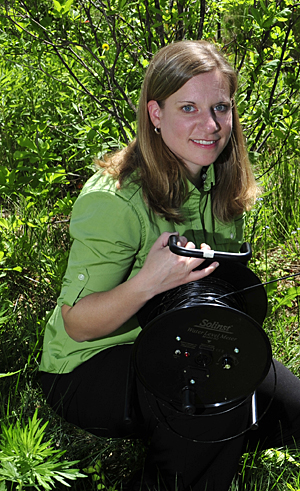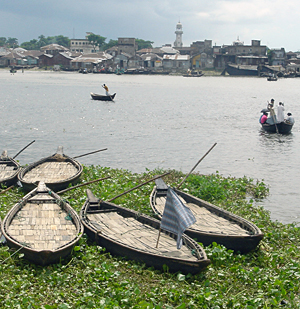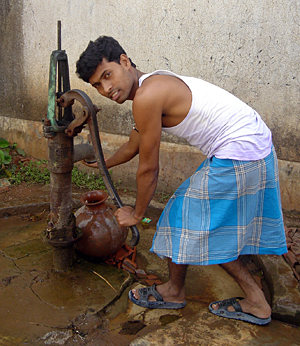


ADVERTISEMENT
- Rozovsky wins prestigious NSF Early Career Award
- UD students meet alumni, experience 'closing bell' at NYSE
- Newark Police seek assistance in identifying suspects in robbery
- Rivlin says bipartisan budget action, stronger budget rules key to reversing debt
- Stink bugs shouldn't pose problem until late summer
- Gao to honor Placido Domingo in Washington performance
- Adopt-A-Highway project keeps Lewes road clean
- WVUD's Radiothon fundraiser runs April 1-10
- W.D. Snodgrass Symposium to honor Pulitzer winner
- New guide helps cancer patients manage symptoms
- UD in the News, March 25, 2011
- For the Record, March 25, 2011
- Public opinion expert discusses world views of U.S. in Global Agenda series
- Congressional delegation, dean laud Center for Community Research and Service program
- Center for Political Communication sets symposium on politics, entertainment
- Students work to raise funds, awareness of domestic violence
- Equestrian team wins regional championship in Western riding
- Markell, Harker stress importance of agriculture to Delaware's economy
- Carol A. Ammon MBA Case Competition winners announced
- Prof presents blood-clotting studies at Gordon Research Conference
- Sexual Assault Awareness Month events, programs announced
- Stay connected with Sea Grant, CEOE e-newsletter
- A message to UD regarding the tragedy in Japan
- More News >>
- March 31-May 14: REP stages Neil Simon's 'The Good Doctor'
- April 2: Newark plans annual 'wine and dine'
- April 5: Expert perspective on U.S. health care
- April 5: Comedian Ace Guillen to visit Scrounge
- April 6, May 4: School of Nursing sponsors research lecture series
- April 6-May 4: Confucius Institute presents Chinese Film Series on Wednesdays
- April 6: IPCC's Pachauri to discuss sustainable development in DENIN Dialogue Series
- April 7: 'WVUDstock' radiothon concert announced
- April 8: English Language Institute presents 'Arts in Translation'
- April 9: Green and Healthy Living Expo planned at The Bob
- April 9: Center for Political Communication to host Onion editor
- April 10: Alumni Easter Egg-stravaganza planned
- April 11: CDS session to focus on visual assistive technologies
- April 12: T.J. Stiles to speak at UDLA annual dinner
- April 15, 16: Annual UD push lawnmower tune-up scheduled
- April 15, 16: Master Players series presents iMusic 4, China Magpie
- April 15, 16: Delaware Symphony, UD chorus to perform Mahler work
- April 18: Former NFL Coach Bill Cowher featured in UD Speaks
- April 21-24: Sesame Street Live brings Elmo and friends to The Bob
- April 30: Save the date for Ag Day 2011 at UD
- April 30: Symposium to consider 'Frontiers at the Chemistry-Biology Interface'
- April 30-May 1: Relay for Life set at Delaware Field House
- May 4: Delaware Membrane Protein Symposium announced
- May 5: Northwestern University's Leon Keer to deliver Kerr lecture
- May 7: Women's volleyball team to host second annual Spring Fling
- Through May 3: SPPA announces speakers for 10th annual lecture series
- Through May 4: Global Agenda sees U.S. through others' eyes; World Bank president to speak
- Through May 4: 'Research on Race, Ethnicity, Culture' topic of series
- Through May 9: Black American Studies announces lecture series
- Through May 11: 'Challenges in Jewish Culture' lecture series announced
- Through May 11: Area Studies research featured in speaker series
- Through June 5: 'Andy Warhol: Behind the Camera' on view in Old College Gallery
- Through July 15: 'Bodyscapes' on view at Mechanical Hall Gallery
- More What's Happening >>
- UD calendar >>
- Middle States evaluation team on campus April 5
- Phipps named HR Liaison of the Quarter
- Senior wins iPad for participating in assessment study
- April 19: Procurement Services schedules information sessions
- UD Bookstore announces spring break hours
- HealthyU Wellness Program encourages employees to 'Step into Spring'
- April 8-29: Faculty roundtable series considers student engagement
- GRE is changing; learn more at April 15 info session
- April 30: UD Evening with Blue Rocks set for employees
- Morris Library to be open 24/7 during final exams
- More Campus FYI >>
12:51 p.m., June 1, 2010----Over 100 million people in rural southern Asia are exposed every day to unsafe levels of arsenic from the well-water they drink. It more than doubles their risks for cancer, causes cardiovascular disease, and inhibits the mental development of children, among other serious effects.
The World Health Organization (WHO) has referred to the situation in Bangladesh, where an estimated 60 million people are affected, as “the largest mass poisoning of a population in history.”
In the May 28 issue of the journal Science, researchers from Stanford University, the University of Delaware, and Columbia University review what scientists understand about this groundwater contamination crisis and offer solutions for the region, which spans Bangladesh, Cambodia, China, India, Myanmar, Nepal, Pakistan, and Vietnam.
Holly Michael, assistant professor of geological sciences in the College of Earth, Ocean, and Environment at the University of Delaware, is a co-author of the article, with Scott Fendorf from Stanford and Alexander van Geen from Columbia University. Fendorf received his doctorate from UD in 1992 and is now chair of environmental and Earth system science at Stanford.
Michael earned her doctorate from the Massachusetts Institute of Technology and joined the UD faculty in 2008. She traveled to Bangladesh to study the groundwater contamination problem firsthand during her postdoctoral training with the U.S. Geological Survey.
Arsenic occurs naturally in the Earth's crust. Tasteless, odorless, and colorless in solution, the element is a known carcinogen and can be detected in water only through testing.
The source of South Asia's arsenic contamination is the Himalaya Mountains. Minerals from rocks, eroding coal seams, and sediments contain arsenic and are carried into the major rivers that flow out of the mountains, including the Indus, Ganges, Brahmaputra, Irawaddy, Meghna, Mekong, and Red rivers. The flat, low-lying floodplains of these major rivers are the areas affected by groundwater contamination.
A logical solution is to dig deeper wells to reach uncontaminated aquifers for supplying safe drinking water. However, farmers also want access to this water to irrigate their rice paddies. And that's a problem, according to Michael's research.
In 2008, Michael showed through numerical modeling of groundwater flow in the Bengal Basin that an uncontaminated domestic well more than 500 feet (150 meters) could remain arsenic-free for at least a thousand years. However, she projected an entirely different scenario for deep irrigation wells, which use mechanized pumps instead of hand pumps to bring groundwater to the surface. The high volumes of water drawn by these irrigation systems induced a much faster downward migration of arsenic-contaminated surface water into the deep aquifer.
“To protect drinking water from arsenic contamination, we recommend that deeper wells only be used by individual households for drinking water and not for crop irrigation,” Michael says.
In addition to preserving deep wells specifically for drinking water, she and her co-authors also recommend these measures:
- Reinvigorating well-testing campaigns by governments and international organizations.
- Better use of existing geological data and the compilation of test results to target zones that are low in arsenic for the installation of community wells.
- The re-testing of tens of thousands of deep wells, particularly those that have been used for both domestic and farming purposes.
- The choice of mitigation option can be situation-dependent: filters or other alternatives may be the best choice in some areas.
“Obviously, arsenic-contaminated drinking water is a huge problem from a human health perspective,” Michael says. “We've shown that there are some viable options in South Asia, but there is much more that we need to understand.”
Currently, Michael is working to model arsenic transport, how it may move in the future in the aquifer system in Bangladesh. She also is working with the World Bank on a study of groundwater sustainability in Bangladesh related to water supply and vulnerability of coastal groundwater to sea-level rise.
Michael's research in the latest issue of Science was supported by the U.S. Geological Survey, the U.S. Agency for International Development, the British Department of International Development, and UNICEF.
Article by Tracey Bryant


